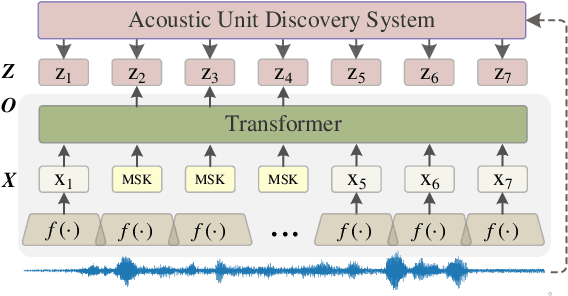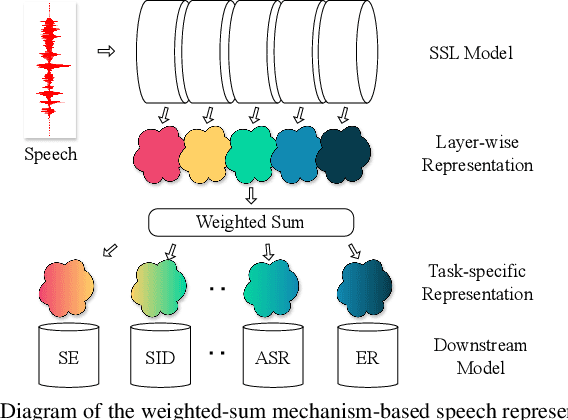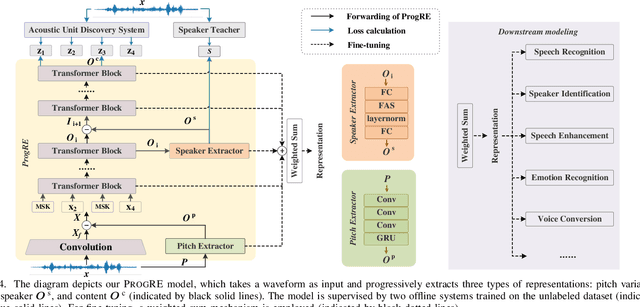Xiaobao Wang
One Prompt Fits All: Universal Graph Adaptation for Pretrained Models
Sep 26, 2025Abstract:Graph Prompt Learning (GPL) has emerged as a promising paradigm that bridges graph pretraining models and downstream scenarios, mitigating label dependency and the misalignment between upstream pretraining and downstream tasks. Although existing GPL studies explore various prompt strategies, their effectiveness and underlying principles remain unclear. We identify two critical limitations: (1) Lack of consensus on underlying mechanisms: Despite current GPLs have advanced the field, there is no consensus on how prompts interact with pretrained models, as different strategies intervene at varying spaces within the model, i.e., input-level, layer-wise, and representation-level prompts. (2) Limited scenario adaptability: Most methods fail to generalize across diverse downstream scenarios, especially under data distribution shifts (e.g., homophilic-to-heterophilic graphs). To address these issues, we theoretically analyze existing GPL approaches and reveal that representation-level prompts essentially function as fine-tuning a simple downstream classifier, proposing that graph prompt learning should focus on unleashing the capability of pretrained models, and the classifier adapts to downstream scenarios. Based on our findings, we propose UniPrompt, a novel GPL method that adapts any pretrained models, unleashing the capability of pretrained models while preserving the structure of the input graph. Extensive experiments demonstrate that our method can effectively integrate with various pretrained models and achieve strong performance across in-domain and cross-domain scenarios.
Active Multimodal Distillation for Few-shot Action Recognition
Jun 16, 2025Abstract:Owing to its rapid progress and broad application prospects, few-shot action recognition has attracted considerable interest. However, current methods are predominantly based on limited single-modal data, which does not fully exploit the potential of multimodal information. This paper presents a novel framework that actively identifies reliable modalities for each sample using task-specific contextual cues, thus significantly improving recognition performance. Our framework integrates an Active Sample Inference (ASI) module, which utilizes active inference to predict reliable modalities based on posterior distributions and subsequently organizes them accordingly. Unlike reinforcement learning, active inference replaces rewards with evidence-based preferences, making more stable predictions. Additionally, we introduce an active mutual distillation module that enhances the representation learning of less reliable modalities by transferring knowledge from more reliable ones. Adaptive multimodal inference is employed during the meta-test to assign higher weights to reliable modalities. Extensive experiments across multiple benchmarks demonstrate that our method significantly outperforms existing approaches.
Integration of Old and New Knowledge for Generalized Intent Discovery: A Consistency-driven Prototype-Prompting Framework
Jun 10, 2025Abstract:Intent detection aims to identify user intents from natural language inputs, where supervised methods rely heavily on labeled in-domain (IND) data and struggle with out-of-domain (OOD) intents, limiting their practical applicability. Generalized Intent Discovery (GID) addresses this by leveraging unlabeled OOD data to discover new intents without additional annotation. However, existing methods focus solely on clustering unsupervised data while neglecting domain adaptation. Therefore, we propose a consistency-driven prototype-prompting framework for GID from the perspective of integrating old and new knowledge, which includes a prototype-prompting framework for transferring old knowledge from external sources, and a hierarchical consistency constraint for learning new knowledge from target domains. We conducted extensive experiments and the results show that our method significantly outperforms all baseline methods, achieving state-of-the-art results, which strongly demonstrates the effectiveness and generalization of our methods. Our source code is publicly available at https://github.com/smileix/cpp.
Single-Node Trigger Backdoor Attacks in Graph-Based Recommendation Systems
Jun 10, 2025Abstract:Graph recommendation systems have been widely studied due to their ability to effectively capture the complex interactions between users and items. However, these systems also exhibit certain vulnerabilities when faced with attacks. The prevailing shilling attack methods typically manipulate recommendation results by injecting a large number of fake nodes and edges. However, such attack strategies face two primary challenges: low stealth and high destructiveness. To address these challenges, this paper proposes a novel graph backdoor attack method that aims to enhance the exposure of target items to the target user in a covert manner, without affecting other unrelated nodes. Specifically, we design a single-node trigger generator, which can effectively expose multiple target items to the target user by inserting only one fake user node. Additionally, we introduce constraint conditions between the target nodes and irrelevant nodes to mitigate the impact of fake nodes on the recommendation system's performance. Experimental results show that the exposure of the target items reaches no less than 50% in 99% of the target users, while the impact on the recommendation system's performance is controlled within approximately 5%.
Rethinking Contrastive Learning in Graph Anomaly Detection: A Clean-View Perspective
May 23, 2025Abstract:Graph anomaly detection aims to identify unusual patterns in graph-based data, with wide applications in fields such as web security and financial fraud detection. Existing methods typically rely on contrastive learning, assuming that a lower similarity between a node and its local subgraph indicates abnormality. However, these approaches overlook a crucial limitation: the presence of interfering edges invalidates this assumption, since it introduces disruptive noise that compromises the contrastive learning process. Consequently, this limitation impairs the ability to effectively learn meaningful representations of normal patterns, leading to suboptimal detection performance. To address this issue, we propose a Clean-View Enhanced Graph Anomaly Detection framework (CVGAD), which includes a multi-scale anomaly awareness module to identify key sources of interference in the contrastive learning process. Moreover, to mitigate bias from the one-step edge removal process, we introduce a novel progressive purification module. This module incrementally refines the graph by iteratively identifying and removing interfering edges, thereby enhancing model performance. Extensive experiments on five benchmark datasets validate the effectiveness of our approach.
Characteristic-Specific Partial Fine-Tuning for Efficient Emotion and Speaker Adaptation in Codec Language Text-to-Speech Models
Jan 24, 2025Abstract:Recently, emotional speech generation and speaker cloning have garnered significant interest in text-to-speech (TTS). With the open-sourcing of codec language TTS models trained on massive datasets with large-scale parameters, adapting these general pre-trained TTS models to generate speech with specific emotional expressions and target speaker characteristics has become a topic of great attention. Common approaches, such as full and adapter-based fine-tuning, often overlook the specific contributions of model parameters to emotion and speaker control. Treating all parameters uniformly during fine-tuning, especially when the target data has limited content diversity compared to the pre-training corpus, results in slow training speed and an increased risk of catastrophic forgetting. To address these challenges, we propose a characteristic-specific partial fine-tuning strategy, short as CSP-FT. First, we use a weighted-sum approach to analyze the contributions of different Transformer layers in a pre-trained codec language TTS model for emotion and speaker control in the generated speech. We then selectively fine-tune the layers with the highest and lowest characteristic-specific contributions to generate speech with target emotional expression and speaker identity. Experimental results demonstrate that our method achieves performance comparable to, or even surpassing, full fine-tuning in generating speech with specific emotional expressions and speaker identities. Additionally, CSP-FT delivers approximately 2x faster training speeds, fine-tunes only around 8% of parameters, and significantly reduces catastrophic forgetting. Furthermore, we show that codec language TTS models perform competitively with self-supervised models in speaker identification and emotion classification tasks, offering valuable insights for developing universal speech processing models.
Enriching Multimodal Sentiment Analysis through Textual Emotional Descriptions of Visual-Audio Content
Dec 12, 2024



Abstract:Multimodal Sentiment Analysis (MSA) stands as a critical research frontier, seeking to comprehensively unravel human emotions by amalgamating text, audio, and visual data. Yet, discerning subtle emotional nuances within audio and video expressions poses a formidable challenge, particularly when emotional polarities across various segments appear similar. In this paper, our objective is to spotlight emotion-relevant attributes of audio and visual modalities to facilitate multimodal fusion in the context of nuanced emotional shifts in visual-audio scenarios. To this end, we introduce DEVA, a progressive fusion framework founded on textual sentiment descriptions aimed at accentuating emotional features of visual-audio content. DEVA employs an Emotional Description Generator (EDG) to transmute raw audio and visual data into textualized sentiment descriptions, thereby amplifying their emotional characteristics. These descriptions are then integrated with the source data to yield richer, enhanced features. Furthermore, DEVA incorporates the Text-guided Progressive Fusion Module (TPF), leveraging varying levels of text as a core modality guide. This module progressively fuses visual-audio minor modalities to alleviate disparities between text and visual-audio modalities. Experimental results on widely used sentiment analysis benchmark datasets, including MOSI, MOSEI, and CH-SIMS, underscore significant enhancements compared to state-of-the-art models. Moreover, fine-grained emotion experiments corroborate the robust sensitivity of DEVA to subtle emotional variations.
EmoPro: A Prompt Selection Strategy for Emotional Expression in LM-based Speech Synthesis
Sep 27, 2024Abstract:Recent advancements in speech synthesis models, trained on extensive datasets, have demonstrated remarkable zero-shot capabilities. These models can control content, timbre, and emotion in generated speech based on prompt inputs. Despite these advancements, the choice of prompts significantly impacts the output quality, yet most existing selection schemes do not adequately address the control of emotional intensity. To address this question, this paper proposes a two-stage prompt selection strategy EmoPro, which is specifically designed for emotionally controllable speech synthesis. This strategy focuses on selecting highly expressive and high-quality prompts by evaluating them from four perspectives: emotional expression strength, speech quality, text-emotion consistency, and model generation performance. Experimental results show that prompts selected using the proposed method result in more emotionally expressive and engaging synthesized speech compared to those obtained through baseline. Audio samples and codes will be available at https://whyrrrrun.github.io/EmoPro/.
Progressive Residual Extraction based Pre-training for Speech Representation Learning
Aug 31, 2024



Abstract:Self-supervised learning (SSL) has garnered significant attention in speech processing, excelling in linguistic tasks such as speech recognition. However, jointly improving the performance of pre-trained models on various downstream tasks, each requiring different speech information, poses significant challenges. To this purpose, we propose a progressive residual extraction based self-supervised learning method, named ProgRE. Specifically, we introduce two lightweight and specialized task modules into an encoder-style SSL backbone to enhance its ability to extract pitch variation and speaker information from speech. Furthermore, to prevent the interference of reinforced pitch variation and speaker information with irrelevant content information learning, we residually remove the information extracted by these two modules from the main branch. The main branch is then trained using HuBERT's speech masking prediction to ensure the performance of the Transformer's deep-layer features on content tasks. In this way, we can progressively extract pitch variation, speaker, and content representations from the input speech. Finally, we can combine multiple representations with diverse speech information using different layer weights to obtain task-specific representations for various downstream tasks. Experimental results indicate that our proposed method achieves joint performance improvements on various tasks, such as speaker identification, speech recognition, emotion recognition, speech enhancement, and voice conversion, compared to excellent SSL methods such as wav2vec2.0, HuBERT, and WavLM.
speech and noise dual-stream spectrogram refine network with speech distortion loss for robust speech recognition
May 30, 2023Abstract:In recent years, the joint training of speech enhancement front-end and automatic speech recognition (ASR) back-end has been widely used to improve the robustness of ASR systems. Traditional joint training methods only use enhanced speech as input for the backend. However, it is difficult for speech enhancement systems to directly separate speech from input due to the diverse types of noise with different intensities. Furthermore, speech distortion and residual noise are often observed in enhanced speech, and the distortion of speech and noise is different. Most existing methods focus on fusing enhanced and noisy features to address this issue. In this paper, we propose a dual-stream spectrogram refine network to simultaneously refine the speech and noise and decouple the noise from the noisy input. Our proposed method can achieve better performance with a relative 8.6% CER reduction.
 Add to Chrome
Add to Chrome Add to Firefox
Add to Firefox Add to Edge
Add to Edge